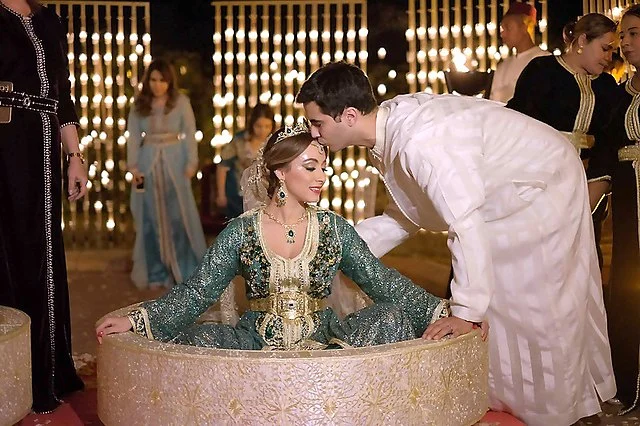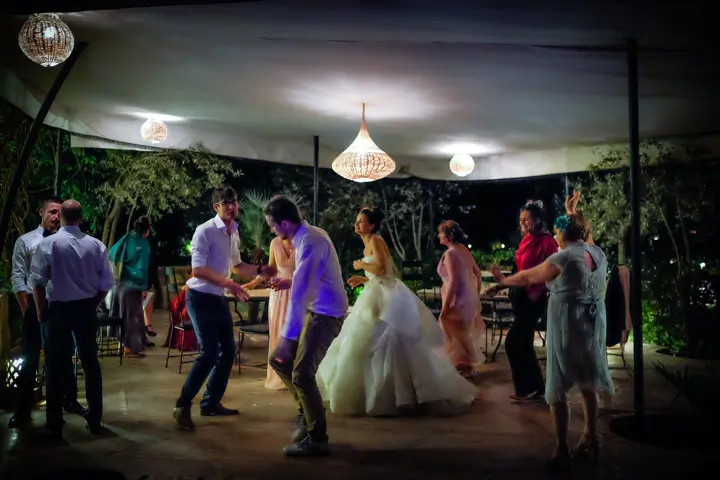Wedding Traditions In Morocco
Morocco is a nation with a deep cultural heritage and enduring traditions. A particularly noticeable aspect of Moroccan culture is its wedding tradition. This article will discuss “Wedding Traditions in Morocco”.
Each nation has a unique tradition of expressing delight or pleasure at weddings. A Moroccan wedding, however, conveys a unique tale of a beautiful way of life and a long history.
The wedding functions start and end with nonstop dancing, a tone of delicious foods, expensive presents, and traditional music.
Wedding Traditions In Morocco
Traditionally, the groom’s family requests the girl’s family for her hand in marriage, and the terms of the wedding are discussed between both families, including the cost of distinct wedding functions, the wedding date, and the bride’s dowry.
When couples are engaged, the bridegroom presents a fancy outfit or accessories to the bride. The first meeting between the groom and bride’s parents is an important and symbolic step. The main wedding functions are:
Drib Sdak
Wedding contracts (Akd zawaj) are signed on this day when the couple and their families are present, as well as an Adoul, a Moroccan official with the right to conclude marriage contracts under Moroccan law.
The couple celebrates their legally and religiously recognized marriage with their closest relatives and friends. Before the extended wedding festivities, the bride organizes a sizable celebration at her parent’s house, where the bridegroom and his family bring presents, including clothes, jewellery, and sweets.
Hammam Ritual
In a Hammam ritual, the bride and her closest female friends and relatives begin the official wedding celebration with a beauty treatment. Massages, exfoliation, waxing, and preparing for the scent all come under this delicate process.
Henna Party
Henna artists are hired to design patterns for the bride’s hands and feet the next day when she wears beautifully designed green kaftans. The Henna artist makes an intriguing and classical design for the bride.
It is believed that henna embodies fertility, beauty, strength, good luck, and protection from evil spirits.
Wedding Day
The wedding ceremony is held in the marriage hall or a private residence, and the Moroccan wedding typically starts at nine o’clock in the evening. It is usual to serve guests milk and dates.
During their first appearance, the couple is wearing Americas. After a banquet of oriental delicious, the bride will quickly change her attire for the wedding festivities under the watchful eye of the Negara. Afterwards, the two families will get together for a lovely lunch at the groom’s family’s home. That is the first meal for the couple.
Moroccan Wedding Dance
Dancing is prevalent at Moroccan weddings. This ritual is typically found at weddings and based on the family; it could even involve a band and performer. Everyone who is physically good at dancing generally does so!
Later in the evening, there’s a chance that a DJ will take over (probably at 2 am). It is required that the band and DJ play the Chaabi, a traditional Moroccan song. Dancing and entertaining the guests are both fantastic with the Chaabi.
Moroccan Engagement Traditions
The marriage preparations in Morocco begin once the bride’s parents consent to the marriage, which is an integral part of the engagement process. The announcement of the engagement is made after both family discussions.
It also determines the dowry and the cost of the wedding celebration. The prospective bridegroom showers her with presents, primarily jewels and clothes.
Moroccan Wedding Dress Rules
In Morocco, weddings are formal affairs. Female visitors dress in various lovely caftans and takchitas (Moroccan dresses) in various hues, fabrics, patterns, and embellishments.
Additionally to the wedding crew, who also dons kaftans and suits, the male guests typically dress in suits. The groom typically begins in a suit, switching to a “jabador” and then a Moroccan male djellaba afterwards.
What do Moroccan brides wear
On the wedding day, a bridal traditionally dress up a “chedda” to represent purity and grace. Generally, the bride dons seven distinct outfits, including:
- Henna ceremony caftan in green and gold
- A white Takchita, which represents innocence
- A Rbatia, frequently blue to symbolize the area of Rabat
- Mejdoub embroidered gold caftan
- The Fascia is a stunning outfit with headdresses worn during the Amaria show.
- A Soussia is a vibrantly decorated gown with Berber designs.
- A Sahraouia is a body-wrapped garment worn in honour of the Moroccan Sahara.
Traditional Moroccan Wedding Gifts
According to Moroccan tradition, the couple receives gifts from their family and friends to set them up for their new journey together as husband and wife. Traditional Moroccan wedding presents are
- Jewellery
- Perfume
- Clothing
- Works of Islamic art
- And house accents
FAQS: Wedding Traditions In Morocco
How many days is a Moroccan wedding?
Moroccan weddings are traditionally seven days long and contain extensive pre-wedding rituals. Before the weddings, the couple’s families are used to hosting parties at their homes.
Naturally, every family member was invited, resulting in numerous days of celebration.
Who Pays For Moroccan Wedding?
No rules have been established for the wedding. Both families may share the cost occasionally. Occasionally, the entire cost is assumed by one side, usually the groom’s family.
Bottom Line
The henna party to the wedding food is all part of the fascinating “wedding traditions in Morocco”. Marriage is an essential aspect of Moroccan culture and a chance for the family to come together and rejoice.
It is worth visiting Morocco due to its amazing traditions, culture, mosques and much more. For a trip of Morocco look no further than Sahara Magic to explore with A Private Experts.





